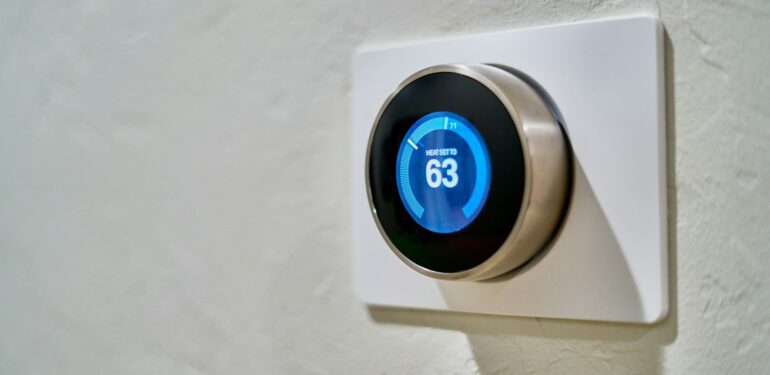The recent rise in the cost of living can put a real strain on your budget if you’re a homeowner. The average utility bill in the U.S. recently topped $429 per month, with folks in Hawaii paying an eye-watering $177.78 monthly for electricity alone.
Fortunately, there are plenty of ways to cut down your bill while keeping your home at a comfortable temperature. Simple changes, like switching out your lightbulbs or planting some bushes, can make a world of difference and help manage the amount you spend on energy.
Eventually, these budget-friendly changes can help you save enough to make larger modifications. This is key, as making sustainable changes to your house can increase the value of your home and help you save money in the long term.
Guest post by Katie Brenneman.
Energy Audit
Before you start making budget-friendly changes to your appliances and insulation, carry out a home energy assessment. A home energy assessment gives you a clear picture of how you’re using energy and can help direct your efforts to reduce your costs and live more sustainably. The Department of Energy explains that you can complete an energy audit yourself by:
- Locating air leaks like gaps in electrical plugs or ceiling panels
- Inspect your attic’s insulation and look for a vapour barrier
- Check the efficiency of your HVAC ductwork for dust streaks and damage
- Estimate the energy used by appliances that are left on even when not in use
This will give you a rough estimate of your energy use and will help you identify a few areas for improvement. If you’re really serious about improving your energy, bring in a professional auditor. Professional auditors are equipped with equipment like thermographic inspection devices that can assess the effectiveness of your insulation and identify areas for improvement.
Lighting
We all rely heavily on artificial lighting in the winter when the days are short, and cloud cover is constant. However, keeping the lights on 24/7 is sure to skyrocket your bill and undermine your desire to live a more eco-friendly lifestyle. Fortunately, there are plenty of eco-friendly, energy-efficient lightbulbs on the market today, including:
- Light-Emitting Diodes (LED): LEDs produce minimal heat and are extremely energy efficient. They last for up to 34 years, too, which can help you justify their higher price.
- Compact Fluorescent Lamps (CFLs): These come in spiral-shaped tubes and are available in a range of hues. They’re cost-effective but will not work below 32 degrees Fahrenheit and take a while to light up properly.
- Halogen Incandescent: Incandescent bulbs use heat to produce light. However, halogen variants are more energy-efficient and still give the same warm glow that folks love.
When shopping for lightbulbs, consider where the socket is and the needs of folks who will be using that space. There’s little use in using a CFL on a front porch or yard, as it may get too cold to light up properly. Similarly, you may want to avoid using LEDs in the bedroom, as the bright blue light could interfere with your sleep cycle.
Heating and Cooling
Heating and cooling your house probably represents the bulk of your utility bill. Keeping your homes at a stable temperature requires a massive amount of energy. You should not try to save money by turning down your HVAC system too much, either, as doing so can quickly lead to hypothermia or heatstroke.
Instead, consider installing modern home features that help you get more from your current system. Items like smart thermostats are eco-friendly and won’t break the bank. They give you a better understanding of your energy use and will keep your home at a stable temperature throughout the day. This is key if you leave your house to work at the office but want to return to a comfortable home at the end of your work day.
If you’re struggling to keep your home cool in the summer months, consider planting some trees for shade outside your house. This will take some time to pay off, but planting a tree from seed will save you money and naturally keep the sun off your home. Just be sure to opt for a plant that suits your climate zone and soil, as this will be more likely to survive when the winter weather rolls in.
Insulation and Air Leaks
Properly insulating your home is a great way to maximize the efficiency of your HVAC system. However, many folks do not realize that their insulation is outdated and ineffective. If you suspect that your home could use an upgrade, bring in a professional who can accurately assess your current insulation.
Full home insulation is extremely expensive. However, you can make a few budget-friendly upgrades to improve your current insulation. Add thick curtains to all of your windows and place door snakes under draft doors. You can even DIY these upgrades to save more money and give your house a unique finish.
While shopping for insulation, consider opting for budget-friendly materials. These will still come at a cost, but materials like sheep wool and mineral wool tend to be more cost-effective. Follow up with DIY projects like adding window film insulation, as this provides benefits akin to double-glazed windows at a fraction of the cost.
Financing Eco-Friendly Upgrades
Big-ticket home upgrades like HVAC systems and solar panels can be expensive. However, you need to consider your longer-term financial position when thinking about home upgrades to improve your energy efficiency. Many of these upgrades will pay dividends in a few years’ time, making them a wise investment for the future.
You can affordably invest in eco-friendly features by using your home equity to fund upgrades. This gives you a lump sum to put towards remodelling and upgrading. Just proceed with caution if you do decide to go down this route, as your home is collateral when tapping into home equity.
You may also be eligible for a Federal Housing Administration (FHA) loan. FHA loans are designed to help folks make eco-friendly upgrades to their house that save money and reduce houses’ environmental footprint. These changes must be considered “cost-effective” by the FHA, or your application will be turned down.
If you’re in a strong financial position, consider using a credit card to pay for major upgrades. This can dramatically improve your credit score and help you become eligible for rewards programs. Just be certain that you can afford to repay the balance, as missing payments will hurt your credit.
While building your savings, consider replacing old appliances with Energy Star alternatives. These alternatives are far more efficient and will save you money in the long term. You can also use smart powerstrips to ensure that the right amount of energy is being used to reduce the impact of “vampire” appliances that suck energy from your home even when they’re not in use.
Maximizing your energy efficiency while on a budget is easier than ever before. There are plenty of smart devices on the market today that can help you control your usage and save money. Likewise, professional home auditors rely on a range of diagnostic devices to spot air leaks and faulty insulation.
This gives you a clear direction to follow and can help you justify spending more cash on new light bulbs or shady trees. Just be sure to set aside some funds for big-ticket items, as you’ll likely need to invest in home upgrades at some point.


